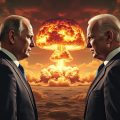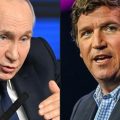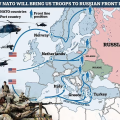
In a recent development that could reshape the ongoing conflict in Ukraine, Russian President Vladimir Putin has expressed a readiness to discuss a ceasefire, but with strings attached. This initiative, which hinges on the mediation of U.S. President-elect Donald Trump, proposes that Ukraine must relinquish its NATO aspirations and accept the current territorial status quo. Here’s a detailed examination of this proposal, its implications, and the potential pathways forward.
The Proposal’s Core Elements
Vladimir Putin’s ceasefire proposal includes several key stipulations:
- No Major Territorial Concessions: Russia would not cede back the territories it currently controls in eastern Ukraine, including parts of Donetsk, Luhansk, Zaporizhzhia, and Kherson, despite international recognition of these regions as part of Ukraine.
- Abandonment of NATO Membership: Ukraine is required to drop its goal of NATO membership, a long-standing ambition aimed at securing Western military support against future Russian aggression.
- Trump’s Mediation: The talks would only proceed with Donald Trump as a mediator, highlighting a strategic alignment with Trump’s known skepticism towards NATO’s expansion and his desire to end the conflict swiftly.
Current Context of the Conflict
The war in Ukraine, escalated in February 2022, has seen fluctuating front lines with significant human and economic costs. The proposal comes at a time when:
- Military Stalemate: Both sides have experienced considerable military fatigue, with Russia controlling roughly 20% of Ukraine’s territory but facing resistance in expanding further.
- International Pressure: Global fatigue over the prolonged conflict and economic sanctions against Russia might push for a diplomatic resolution.
- U.S. Political Shift: Trump’s election victory, with his past statements on quickly resolving the conflict, sets a stage for potential U.S. involvement in peace negotiations.
Analysis: Feasibility and Challenges
**1. Feasibility of the Proposal:
- Political Will: Trump’s involvement could indeed be a catalyst. His previous term showed a willingness to engage directly with Putin, potentially bypassing traditional diplomatic channels which might expedite talks.
- Economic Incentives: Ending the war could relieve economic pressures on both nations involved, particularly on Russia, which faces sanctions and an economic downturn due to the conflict.
**2. Challenges and Ukrainian Perspective:
- Sovereignty Concerns: For Ukraine, accepting the current territorial lines means acknowledging Russian control over significant regions, which could be seen domestically as a capitulation. This might not align with the Ukrainian populace’s or government’s stance on territorial integrity.
- Security Guarantees: Without NATO, Ukraine seeks alternative security guarantees. The proposal’s success hinges on credible commitments from the international community to protect Ukraine from future Russian aggression.
**3. Potential for Success:
- Mutual Exhaustion: Both nations might see value in a ceasefire due to the high costs of continued conflict. A temporary halt could serve as a reset for political negotiations.
- Strategic Pause: For Putin, this could be a strategic pause to consolidate gains, reassess military strategies, and perhaps negotiate from a position of territorial fact. For Ukraine, it might provide time to rebuild and strengthen defenses with Western support.
**4. Why It Might Work:
- Trump’s Influence: His personal diplomacy style might circumvent traditional diplomatic deadlocks, focusing on deal-making which could be beneficial in such negotiations.
- Global Stability: The international community, especially European nations, would likely support any measure reducing the risk of escalation or further destabilization in the region.
- Economic Recovery: Both Russia and Ukraine, along with the global economy, would benefit from ending the conflict, potentially leading to sanctions relief or restructuring for Russia and economic stabilization for Ukraine.
Conclusion
Vladimir Putin’s ceasefire proposal, while rooted in Russian strategic interests, offers a pathway to peace that could be viable under certain conditions:
- Mediation by Trump could provide a unique diplomatic avenue, leveraging his personal rapport with Putin.
- Ukrainian concessions on NATO would need to come with robust security assurances from other quarters, possibly the EU or a new security framework involving neutral countries.
- Economic incentives for peace could drive internal support in both countries for such an agreement.
The success of this proposal would depend not just on the willingness of the involved parties but on how well the international community can balance security assurances with the realities of territorial control. The proposal, if handled with nuanced diplomacy, might pave the way for a long-term peace, albeit one that requires significant compromises from Ukraine. However, it also risks setting a precedent where military aggression could lead to territorial gains, a concern for international law and order.








